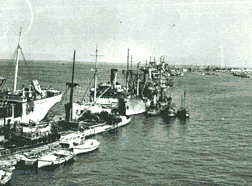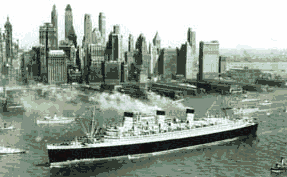D-Day 1944 and Why They Owe Me a Trip on the Queen Mary
by Richard R. Powers
On March 1, 1944, the War Shipping Administration made me an offer I couldn't refuse: take a ship on its maiden voyage to England and return to the States on the Queen Mary. I could not wait to get aboard, get that ship delivered, and step on the deck of the one and only Queen Mary!
The next day I went down to the docks in Baltimore and got aboard the SS Vitruvius. After getting aboard, I couldn't help notice the ship was different from anything I had been on before. She was built of solid concrete. I wondered if this thing would float and get us across the Atlantic? I saw stevedores loading lumber in all the holds, which made me feel somewhat better, so I signed on as Able Bodied seaman. After all, I couldn't keep the Queen Mary waiting!
Photo of Richard R. Powers, October 1943
We left Baltimore on March 5, and met our convoy just outside Charleston, South Carolina. It wasn't a pretty sight: 15 old "rustpots," including the Panamanian-flag SS Olambala built in 1901. There were WWI-era Hog Islanders, crippled Liberty Ships, and another concrete ship, SS David O. Saylor. We looked like a floating junkyard.
We made the Atlantic Ocean crossing without any U-boat attacks -- I guess they were too smart to waste torpedoes on us -- but were rammed by a ship in our convoy. I will never forget the sight of the Bosun getting a sack of concrete to patch up the cracks. At an average speed of three knots, it took us 33 days to Liverpool. There we unloaded our cargo of lumber.
I asked about the trip back on the Queen, and was told to be patient. A week later I asked again, and couldn't get a straight answer. Oh well, I did volunteer!
News spread there was a concrete ship in port and lots of locals came to see it. One old gentleman used his walking stick to tap on the hull "to make sure it was really concrete."
SS John Smeaton, sister ship of SS VitruviusOne day Army Engineers came aboard with several cases of dynamite and set up charges in each hold. On June 1 we headed out to sea. About two days out, the Captain called all hands on deck to read a letter from General Dwight D. Eisenhower telling us we would be making history -- participating in the invasion of Normandy.
We rendezvoused at Portsmouth, England with the others destined to be "blockships." Crossing the channel on D-Day was not a big problem for us. The Army put a Sergeant on board, who slept with his rifle at his side all the way across. Those "dogfaces" could sleep anywhere! We woke him when we got there, and were glad we didn't need his services!
The coast of France was a sight to behold. Ships everywhere. Battleships with guns blasting the shoreline. Destroyers, destroyer escorts, and every kind of landing craft imaginable.
The day was cloudy, but occasionally a plane would stick its nose through the clouds, and every ship, including ours, would fire their 20 mm Oerlikons. It was the 4th of July multiplied tenfold.
We had a birds-eye view of landing craft heading for shore, the fighting on the beach, and bodies floating in the water. I was sure glad to be on a ship -- even if it was concrete.
On D-Day+1 we tried to maneuver to our assigned position, but German 88s started exploding around us. We got out of there just in time. We tried again on D-Day+3 with the same results. On D-Day+4 we went in without any problem. We got off the ship into an LCI, and watched Army Engineers set off the dynamite. A big puff of smoke, and she sank quickly in the shallow water with about half the ship still showing.
Blockships forming Gooseberry breakwater at NormandyFrom the LCI we boarded a troopship which took us to Bournemouth, England. By then we were very hungry because, due to the extra time it took to sink our ship, we ran out of food aboard the Vitruvius.The British fed us a meal of cabbage, boiled potatoes, and hard rolls -- and we were grateful for it.
True to their word, all the crew was put on the Queen Mary except for 5 of us. We volunteered to stand by in Liverpool as replacements for crew members killed or wounded. I missed my chance to sail on the Queen Mary!
Queen Mary arriving New York on her maiden voyage, 1936At the end of July, I was sent to Belfast, Ireland as a replacement on a Liberty ship going back to the states. After a little R&R, I reported to Fort Trumbull U. S. Maritime Service Officers Training School in New London, Connecticut. I graduated in 1945 as an Ensign in the U. S. Maritime Service, received a 3rd Mate's license, and returned to sea.
During one of my voyages we went to Rome to bring home troops originally headed for the invasion of Japan. They were a happy group and so were we!
SS Vitruvius was launched 12/1943 at McCloskey & Co. Hookers Point, Tampa Florida for the U.S. Maritime Commission
Specifications: C-1-S-D1, concrete hull, 366 feet long, 54 foot beam, 3 cylinder triple expansion steam engine, 1,300 horsepower, 4,825 gross tons. Speed 7 knots. 24 were built and most were soon used for breakwaters. The concrete ships were named for experts in the development and use of concrete, including a Roman engineer named Vitruvius Pollio who lived in the first century B.C.Queen Mary (1936 - 1967) was launched at John Brown & Co Ltd, Glasgow, 26 September 1934 for Cunard
Specifications: Steel hull, 1019 feet long overall, 118 foot beam, quadruple screw, single reduction steam turbines, 80,774 gross tons, 3 funnels. Service speed 29 knots1,000 American mariners were among the crews of the blockships.
Sources
SS John Smeaton illustration: From America to United States: The History of the long-range Merchant Shipbuilding Programme of the Unites States Maritime Commission (1937-1952) Part 3, L.A. Sawyer and W.H.Mitchell London: World Ship Society, 1984
Blockship photograph courtesy of Perry Adams
SS Queen Mary illustration http://www.queenmary.com/
Statistics http://www.cunardline.com/6/5/00
www.USMM.org ©1998, 1999, 2000. You may quote material on this web page as long as you cite American Merchant Marine at War, www.usmm.org, as the source. You may not use more than a few lines without permission. If you see substantial portions of this page on the Internet or in published material please notify usmm.org @ comcast.net


